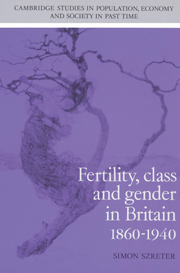Book contents
- Frontmatter
- Contents
- List of figures
- List of tables
- Acknowledgements
- List of abbreviations
- Introduction
- Part I Historiographical introduction: a genealogy of approaches
- Part II The professional model of social classes: an intellectual history
- Prologue: the fertility census of 1911 and the professional model of social classes
- 2 Social classification of occupations and the GRO in the nineteenth century
- 3 Social classification and nineteenth-century naturalistic social science
- 4 The emergence of a social explanation of class inequalities among environmentalists, 1901–1904
- 5 The emergence of the professional model as the official system of social classification, 1905–1928
- Part III A new analysis of the 1911 census occupational fertility data
- Part IV Conceptions and refutations
- Appendices
- Bibliography
- Index
- Cambridge Studies in Population, Economy and Society in the Past Time
5 - The emergence of the professional model as the official system of social classification, 1905–1928
Published online by Cambridge University Press: 16 February 2010
- Frontmatter
- Contents
- List of figures
- List of tables
- Acknowledgements
- List of abbreviations
- Introduction
- Part I Historiographical introduction: a genealogy of approaches
- Part II The professional model of social classes: an intellectual history
- Prologue: the fertility census of 1911 and the professional model of social classes
- 2 Social classification of occupations and the GRO in the nineteenth century
- 3 Social classification and nineteenth-century naturalistic social science
- 4 The emergence of a social explanation of class inequalities among environmentalists, 1901–1904
- 5 The emergence of the professional model as the official system of social classification, 1905–1928
- Part III A new analysis of the 1911 census occupational fertility data
- Part IV Conceptions and refutations
- Appendices
- Bibliography
- Index
- Cambridge Studies in Population, Economy and Society in the Past Time
Summary
Infant mortality: the focus of scientific debate
The official Reports of 1903 and 1904 only represented the initial exchange of hostilities between hereditarians and environmentalists. The post-Boer War inquests proved to be the start of a continuous battle by appeal to the evidence as each side sought to show greater congruence between its own theory and the facts of poverty: the associated class-differential patterns of mortality and fertility. Inspired by Galton's attribution of a eugenic scale of evaluation to Booth's social class scheme, there soon appeared eugenic studies, purporting to measure the reproduction of the various social groups within the nation.
In a research report published in 1906 David Heron, one of Pearson's assistants at the UCL (University College, London) Biometric Laboratory endowed by Galton, attempted the first ‘thorough’ eugenic treatment of the subject: ‘On the relation of fertility in man to social status changes in the last fifty years’. In Heron's study, the main empirical undertaking consisted of producing correlation coefficients between various indices constructed from official sources, relating to the observable socio-demographic traits of the populations of administrative districts. Of course, the assumption involved in such a procedure, for any causal inference to be validly derived, was that the attributes were formally independent.
- Type
- Chapter
- Information
- Fertility, Class and Gender in Britain, 1860–1940 , pp. 238 - 282Publisher: Cambridge University PressPrint publication year: 1996

